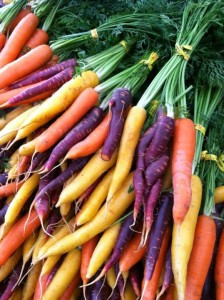Week 13, October 3
Both boxes have: Nash Red Kale, Red Beets with Greens, Napa Cabbage, Rainbow Carrots, Red Potatoes, Bartlett Pears, Naked Oats
The Small box also has: Baby Bok Choi
The Standard box also has: Corn, Apples
Naked Oats
The Naked Oats in your box this week are a variety called “Streaker.” Nash has focused on growing hull-less oats because when put through the combine, the grain loses its tough outer hull, and doesn’t require further de-hulling to cook and eat.
About 7 years ago, we tried growing naked oats, but the variety didn’t do well. Last year, Sam McCullough and the crew tried Streaker with success. This summer, our crop of about 8 acres was harvested in late August, yielding about 20,000 pounds of hull-less oats. We anticipate it will supply our store, markets, and farm shares until late summer 2015, when we harvest the next planting. With careful planning and attention to detail, we have been able to make an entirely new product available to our community, and increase the diversity of the grains we grow in the Dungeness Valley.
There are many health benefits of whole, hull-less oats. Traditional oats are 70‐75% digestible, whereas hull-less oats are 95% digestible. They still have the bran and germ, the source of soluble fiber and high protein, making them a good choice for folks at risk for heart disease, high blood pressure, or stroke.
Pre‐soaking naked oats gives you a jump on the cooking time. Place them in a bowl or cooking pot and cover with water overnight. In the morning, drain and add fresh water. They will cook in much less time.
Check our Recipe Blog for other ways to cook naked oats.
Also, an easy Crockpot Oatmeal with Nash’s Naked Oats
There’s no rule that says oatmeal needs to be served sweet. Try cooking the oatmeal and then mixing it hot with 1/2 cup of a strong-flavored grated cheese, like a sharp cheddar or smoked Gouda. Top it with a mixture of sautéed sliced onions and mushrooms, minced garlic, 1/2 tsp. dried thyme and salt and pepper to taste. Now there’s a breakfast that will kick-start your day!
Rainbow Carrots
Colorful carrots are not new. Purple and yellow carrots were grown in Afghanistan about 1,000 years ago, but for some reason, as carrots migrated into Europe, orange carrots were preferred, because they were more cold-tolerant. In the last 50 years, plant breeders have sought to bring the old varieties back.
Lots of color in produce indicates lots of phytochemicals. The more color you add to your diet, the healthier it is for you. Phytochemicals are compounds found naturally in plants that have only recently been studied in any depth. They are not considered “essential nutrients,” but appear to have effects on many human diseases.
The phytonutrients in these carrots help your body maintain good health. Orange indicates the presence of carotenes which promote healthy eyes. Purple have carotenes plus anthocyanin which help prevent heart disease. Yellow have xanthophykks and lutein, both of which help prevent cancer as well.

